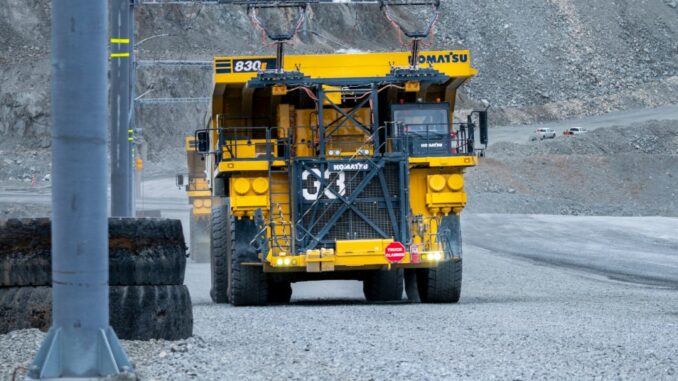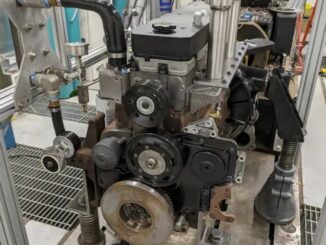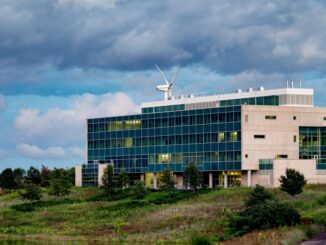
The following story is the third in a series produced in collaboration with KAXE/KBXE, an independent, nonprofit community radio station that tells the stories of northern Minnesota.
A Minnesota taconite mining company and its electric utility are seeking federal funding for a demonstration project aimed at slashing diesel fuel use and greenhouse gas emissions.
After an unsuccessful attempt to secure money this spring from the state Legislature, U.S. Steel and Minnesota Power have applied for a U.S. Department of Energy grant in hopes of kickstarting the project, which seeks to test a system to partially power mining trucks with electricity.
Once loaded, the enormous vehicles would connect to overhead power lines for the steepest part of their climb from the open pit mine. Running on electricity for that portion could reduce diesel fuel use by 70% per trip, according to the companies’ presentation to legislators earlier this year.
That also means a dramatic reduction in greenhouse gas emissions. A new Minnesota law requires power companies to only sell clean electricity by 2040, a target that Minnesota Power is making progress toward. If powered by carbon-free electricity, one mine trolley in the U.S. Steel demonstration project would equate to replacing 520 gas-powered vehicles with electric on Minnesota’s roads, each year.
David Chura, manager of emerging initiatives for Minnesota Power’s parent company ALLETE, said the pilot project would provide insight into whether trolley systems could be scaled across the industry. The steel industry is seeing growing pressure from government, investors, and customers to lower its climate impact. U.S. Steel has committed to achieving net-zero carbon emissions by 2050.
With the corporate green energy goals of Minnesota Power and U.S. Steel in mind, Chura said exploring applications of electrification in industrial settings was a natural step.
“We developed some model mines based on characteristics of actual mines here on the on the Iron Range,” Chura said. “That really helped inform our understanding of mine truck electrification and the opportunities here.”
Chura said energy savings are site-specific, meaning it depends on the steepness of the grade, the length of the haul and other factors. But this project’s anticipated fuel savings are 1.4 million gallons of diesel each year, amounting to 14,000 metric tons of carbon emissions. With those figures, mine trolleys could be a key approach to climate-friendly practices.
“That’s a very significant reduction of emissions as well as criteria pollutants in a key area of the state,” Chura said, noting the area’s proximity to the Boundary Waters, Voyageurs National Park, and state-designated environmental justice communities.
The idea of electric-powered mining trucks isn’t new. The 1970s oil crisis prompted numerous studies exploring benefits, according to mining electrification and automation company ABB. Despite this history, adoption has been slow. But ABB, which produces mine trolley systems, said recent projects demonstrating positive impacts show demand is on the rise. This includes in an open pit copper mine in Sweden operated by mining company Boliden.
Battery-powered electric mining trucks — which wouldn’t require hitching to a trolley line for hauling — are also moving closer to viability. In 2022, Caterpillar announced it successfully demonstrated a prototype of its first battery-powered truck at the company’s Tuscon, Arizona, proving grounds. The facility is set up to test sustainable solutions mining companies can use in their operations, offering firsthand experience with what it takes to run an electrified mining site.
Other types of clean fuel options are emerging, too. According to Caterpillar, green hydrogen production, fuel cell power generation and energy storage systems are all part of the equation.
“The site will also leverage a variety of renewable power sources, including wind, solar and hydrogen, capable of powering the facility and its products as they become electrified,” a news release stated. “The transformation of the facility will also serve as a learning platform for optimizing charging and energy management integration.”
The project in Minnesota would focus on converting existing trucks that operate on a diesel-electric hybrid system, similar to rail locomotives. Chura says some of these trucks, which have electric motors on each wheel, are already in use on the Iron Range.
Converting a truck to utilize overhead power lines to run the motors costs about $1.1 million, according to a presentation prepared for the Minnesota Legislature. The infrastructure costs would run $5 million-$8 million per mile, according to Chura. But the lines would be installed on the steepest parts of the trucks’ route, where the diesel engine works the hardest, resulting in substantial fuel savings.
“Just as the state has helped incentivize residential and commercial electric vehicle service, funding from either the state or the feds would help achieve those same benefits, but yet, at an industrial scale,” Chura said. “And those benefits really benefit all taxpayers.”
Bills were introduced in the state House and Senate this year to provide a $10 million grant, but they didn’t make it out of committee.
John Arbogast, District 11 staff representative for the United Steelworkers, testified in committee on behalf of the bill.
“Even some of the people that you thought might have been opposed to it were like, ‘Holy cow, is this interesting,’” Arbogast said.
Arbogast spent 26 years working at U.S. Steel’s MinnTac mine in Mountain Iron and is now the co-chair of the Iron Ore Alliance, a partnership between U.S. Steel and the United Steelworkers. He said environmental policy issues are one subject on which the union and the company often find agreement.
The trolley system would also increase the speed of the trucks as they travel up the incline, an aspect Arbogast said he thinks will appeal to the mining truck drivers.
“I think our members, the men and women who drive the trucks, will really like that,” he said. “Because they’re really good at what they do, and they have a lot of pride in hauling the ore to the crusher and getting as many loads as they can in their 12-hour shifts.”
Chura noted that the faster speeds mean a site could potentially get by with fewer trucks, which can cost millions of dollars each.
State Sen. Grant Hauschild, DFL-Hermantown, was chief author of the bill. He said he’s committed to fighting for the project into the future as part of an overall approach to a cleaner energy economy.
“Our mines are a critical part of that effort, and so why don’t we look for opportunities to move towards a cleaner industry, while also providing the very minerals and resources that we need in order to transition?” Hauschild said. “I think it’s a really a perfect putting-together of the puzzle pieces that make our region so strong and vital.”
The project partners turned their sights toward the federal government, applying for funds through the Department of Energy’s Office of Clean Energy Demonstrations. About $6 billion will fund projects aimed at reducing emissions in industrial subsectors, with award announcements expected early next year.



